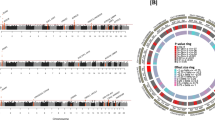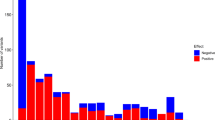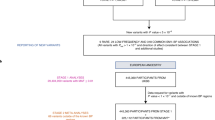Abstract
Platelet function mediates both beneficial and harmful effects on human health, but few genes are known to contribute to variability in this process. We tested association of 2.5 million SNPs with platelet aggregation responses to three agonists (ADP, epinephrine and collagen) in two cohorts of European ancestry (N ≤ 2,753 in the Framingham Heart Study, N ≤ 1,238 in the Genetic Study of Atherosclerosis Risk). We identified associations of seven loci with platelet aggregation near or within GP6 (P = 4.6 × 10−13), PEAR1 (P = 3.4 × 10−12), ADRA2A (P = 3.3 × 10−11), PIK3CG (P = 3.1 × 10−9), JMJD1C (P = 1.6 × 10−8), MRVI1 (P = 2.0 × 10−8) and SHH (P = 4.5 × 10−8). Six of these loci replicated at P < 0.05 in an additional African-American cohort (N ≤ 840 in the Genetic Study of Atherosclerosis Risk). These results provide insights into platelet aggregation pathways and may suggest new antiplatelet therapeutic targets.
This is a preview of subscription content, access via your institution
Access options
Subscribe to this journal
Receive 12 print issues and online access
$209.00 per year
only $17.42 per issue
Buy this article
- Purchase on Springer Link
- Instant access to full article PDF
Prices may be subject to local taxes which are calculated during checkout


Similar content being viewed by others
Accession codes
References
Wolff, T., Miller, T. & Ko, S. Aspirin for the primary prevention of cardiovascular events: an update of the evidence for the U.S. Preventive Services Task Force. Ann. Intern. Med. 150, 405–410 (2009).
Quinn, M.J. & Topol, E.J. Common variations in platelet glycoproteins: pharmacogenomic implications. Pharmacogenomics 2, 341–352 (2001).
Faraday, N., Becker, D.M. & Becker, L.C. Pharmacogenomics of platelet responsiveness to aspirin. Pharmacogenomics 8, 1413–1425 (2007).
O'Donnell, C.J. et al. Genetic and environmental contributions to platelet aggregation: the Framingham Heart Study. Circulation 103, 3051–3056 (2001).
Bray, P.F. et al. Heritability of platelet function in families with premature coronary artery disease. J. Thromb. Haemost. 5, 1617–1623 (2007).
Salles, I.I. et al. Inherited traits affecting platelet function. Blood Rev. 22, 155–172 (2008).
Yang, Q., Kathiresan, S., Lin, J.P., Tofler, G.H. & O'Donnell, C.J. Genome-wide association and linkage analyses of hemostatic factors and hematological phenotypes in the Framingham Heart Study. BMC Med. Genet. 8, S12 (2007).
Herrera-Galeano, J.E. et al. A novel variant in the platelet endothelial aggregation receptor-1 gene is associated with increased platelet aggregability. Arterioscler. Thromb. Vasc. Biol. 28, 1484–1490 (2008).
Jones, C.I., et al. & on behalf of the Bloodomics consortium A functional genomics approach reveals novel quantitative trait loci associated with platelet signaling pathways. Blood 114, 1405–1416 (2009).
Freeman, K. et al. Genetic polymorphism of the α2-adrenergic receptor is associated with increased platelet aggregation, baroreceptor sensitivity, and salt excretion in normotensive humans. Am. J. Hypertens. 8, 863–869 (1995).
Kambayashi, J. et al. Prevalence of impaired responsiveness to epinephrine in platelets among Japanese. Thromb. Res. 81, 85–90 (1996).
Croft, S.A. et al. Novel platelet membrane glycoprotein VI dimorphism is a risk factor for myocardial infarction. Circulation 104, 1459–1463 (2001).
Joutsi-Korhonen, L. et al. The low-frequency allele of the platelet collagen signaling receptor glycoprotein VI is associated with reduced functional responses and expression. Blood 101, 4372–4379 (2003).
Nanda, N. et al. Platelet endothelial aggregation receptor 1 (PEAR1), a novel epidermal growth factor repeat-containing transmembrane receptor, participates in platelet contact-induced activation. J. Biol. Chem. 280, 24680–24689 (2005).
Yabe, M. et al. Identification of ADRA2A polymorphisms related to shear-mediated platelet function. Biochem. Biophys. Res. Commun. 347, 1001–1005 (2006).
Small, K.M., Brown, K.M., Seman, C.A., Theiss, C.T. & Liggett, S.B. Complex haplotypes derived from noncoding polymorphisms of the intronless α2A-adrenergic gene diversify receptor expression. Proc. Natl. Acad. Sci. USA 103, 5472–5477 (2006).
Trifiro, E. et al. The low-frequency isoform of platelet glycoprotein VIb attenuates ligand-mediated signal transduction but not receptor expression or ligand binding. Blood 114, 1893–1899 (2009).
Massberg, S. et al. A crucial role of glycoprotein VI for platelet recruitment to the injured arterial wall in vivo. J. Exp. Med. 197, 41–49 (2003).
Bezemer, I.D. et al. Gene variants associated with deep vein thrombosis. J. Am. Med. Assoc. 299, 1306–1314 (2008).
Tregouet, D.A. et al. Common susceptibility allele are unlikely to contribute as strongly as the FV and ABO loci to VTE risk: results from a GWAS approach. Blood 113, 5298–5303 (2009).
Schlossmann, J. et al. Regulation of intracellular calcium by a signaling complex of IRAG, IP3 receptor and cGMP kinase Ibeta. Nature 404, 197–201 (2000).
Antl, M. et al. IRAG mediates NO/cGMP-dependent inhibition of platelet aggregation and thrombus formation. Blood 109, 552–559 (2007).
Martínez, M.C. et al. Transfer of differentiation signal by membrane microvesicles harboring hedgehog morphogens. Blood 108, 3012–3020 (2006).
Soranzo, N. et al. A novel variant on chromosome 7q22.3 associated with mean platelet volume, counts, and function. Blood 113, 3831–3837 (2009).
Schoenwaelder, S.M. et al. Identification of a unique co-operative phosphoinositide 3-kinase signaling mechanism regulating integrin αIIbβ3 adhesive function in platelets. J. Biol. Chem. 282, 28648–28658 (2007).
Yowe, D. et al. RGS18 is a myeloerythroid lineage-specific regulator of G-protein-signaling molecule highly expressed in megakaryocytes. Biochem. J. 359, 109–118 (2001).
Gagnon, A.W., Murray, D.L. & Leadley, R.J. Cloning and characterization of a novel regulator of G protein signaling in human platelets. Cell. Signal. 14, 595–606 (2002).
Kim, S.D. et al. The expression patterns of RGS transcripts in platelets. Platelets 17, 493–497 (2006).
García, A. et al. Differential proteome analysis of TRAP-activated platelets: involvement of DOK-2 and phosphorylation of RGS proteins. Blood 103, 2088–2095 (2004).
Guidetti, G.F. et al. The Gi-coupled P2Y12 receptor regulates diacylglycerol-mediated signaling in human platelets. J. Biol. Chem. 283, 28795–28805 (2008).
Cannobbio, I. et al. Genetic evidence for a predominant role of PI3Kβ catalytic activity in ITAM- and integrin-mediated signaling in platelets. Blood 114, 2193–2196 (2009).
Wang, Z. et al. Rap1b is critical for glycoprotein VI-mediated but not ADP receptor-mediated α2β1 activation. J. Thromb. Haemost. 7, 693–700 (2009).
Chrzanowska-Wodnicka, M. et al. Rap1b is required for normal platelet function and hemostasis in mice. J. Clin. Invest. 115, 680–687 (2005).
Letschka, T. et al. PKC-θ selectivity controls the adhesion-stimulating molecule Rap1. Blood 112, 4617–4627 (2008).
Severson, E.A., Lee, W.Y., Capaldo, C.T., Nusrat, A. & Parkos, C.A. Junctional adhesion molecule A interacts with Afadin and PDZ-GEF2 to activate Rap1a, regulate β1 integrin levels, and enhance cell migration. Mol. Biol. Cell 20, 1916–1925 (2009).
Ellies, L.G. et al. Sialyltransferase ST3Gal-IV operates as a dominant modifier of hemostasis by concealing asialoglycoprotein receptor ligands. Proc. Natl. Acad. Sci. USA 99, 10042–10047 (2002).
Grewal, P.K. et al. The Ashwell receptor mitigates the lethal coagulopathy of sepsis. Nat. Med. 14, 648–655 (2008).
Holada, K., Glierova, H., Simak, J. & Vostal, J.G. Expression of cellular prion protein on platelets from patients with gray platelet or Hermansky-Pudlak syndrome and the protein's association with α-granules. Haematologica 91, 1126–1129 (2006).
Jones, M. et al. Human platelets as a substrate source for the in vitro amplification of the abnormal prion protein (PrPSc) associated with variant Creutzfeldt-Jakob disease. Transfusion 49, 376–384 (2009).
Meisinger, C. et al. A genome-wide association study identifies three loci associated with mean platelet volume. Am. J. Hum. Genet. 84, 66–71 (2009).
Johnson, A.D. et al. SNAP: a web-based tool for identification and annotation of proxy SNPs using HapMap. Bioinformatics 24, 2938–2939 (2008).
Shaughnessy, J.D. et al. Mrvil, a common MRV integration site in BXH2 myeloid leukemias, encodes a protein with homology to a lymphoid-restricted membrane protein Jaw1. Oncogene 18, 2069–2084 (1999).
Watkins, N.A. et al. A HaemAtlas: characterizing gene expression in differentiated human blood cells. Blood 113, e1–e9 (2009).
Kannel, W.B., Feinleib, M., McNamara, P.M., Garrison, R.J. & Castelli, W.P. An investigation of coronary heart disease in families: the Framingham Offspring Study. Am. J. Epidemiol. 110, 281–290 (1979).
Mukamal, K.J. et al. Alcohol consumption and platelet activation and aggregation among women and men: The Framingham Offspring Study. Alcohol. Clin. Exp. Res. 29, 1906–1912 (2005).
Becker, D.M. et al. Sex differences in platelet reactivity and response to low-dose aspirin therapy. J. Am. Med. Assoc. 295, 1420–1427 (2006).
Price, A.L. et al. Principal components analysis corrects for stratification in genome-wide association studies. Nat. Genet. 38, 904–909 (2006).
Chen, M.H. & Yang, Q. GWAF: an R package for genome-wide association analysis with family data. Bioinformatics 26, 580–581 (2010).
Littell, R.C., Milliken, G.A., Stroup, W.W. & Wolfinger, R.D. SAS System for Mixed Models. (SAS Institute, Cary, North Carolina, 1996).
Acknowledgements
This work was supported by the US National Heart, Lung, and Blood Institute's Framingham Heart Study (Contract No. N01-HC-25195) and its contract with Affymetrix, Inc. for genotyping services (Contract No. N02-HL-6-4278). This research was conducted in part using data and resources from the Framingham Heart Study of the National Heart, Lung, and Blood Institute of the National Institutes of Health and Boston University School of Medicine. The analyses reflect intellectual input and resource development from the Framingham Heart Study investigators participating in the SNP Health Association Resource (SHARe) project. A portion of this research used the Linux Cluster for Genetic Analysis (LinGA-II) funded by the Robert Dawson Evans Endowment of the Department of Medicine at Boston University School of Medicine and Boston Medical Center. This work was supported by the National Heart, Lung, and Blood Institute through the PROGENI (U01 HL72518) and STAMPEED (R01 HL087698-01) consortia, and through R01-HL-48157. This research was conducted in part using the resources of the Johns Hopkins General Clinical Research Center, funded through the National Center for Research Resources, M01-RR000052 and the Washington University DSG cluster. We thank G. Ehret and S. Ganesh for providing R code that was modified to generate plots displayed in Figures 1 and 2 and Supplementary Figure 2.
Author information
Authors and Affiliations
Contributions
A.D.J., L.R.Y., C.J.O. and L.C.B. led the study. A.D.J. took primary responsibility for drafting the manuscript with contributions and editing from L.R.Y., M.-H.C., N.F., M.G.L., G.T., A.T.K., Q.Y., D.M.B., C.J.O. and L.C.B. G.T., M.G.L. and C.J.O. were involved in the original guidance, collection and analysis of Framingham platelet phenotype data. L.R.Y., N.F., D.M.B. and L.C.B. were involved in the guidance, collection and analysis for the Genetic Study of Atherosclerosis Risk (GeneStar) phenotype data. S.J.L., A.T.K. and M.A.P. designed the database and analysis system used in GeneStar analyses. A.D.J., L.R.Y. and M.-H.C. conducted genome-wide association analyses. A.D.J., L.R.Y., M.-H.C. and A.T.K. conducted additional analyses on SNP replication and the percent of variance explained. M.-H.C. conducted the meta-analyses. All authors read and approved the final version of the manuscript.
Corresponding author
Ethics declarations
Competing interests
The authors declare no competing financial interests.
Supplementary information
Supplementary Text and Figures
Supplementary Tables 1–5 and Supplementary Figures 1–3 (PDF 2567 kb)
Rights and permissions
About this article
Cite this article
Johnson, A., Yanek, L., Chen, MH. et al. Genome-wide meta-analyses identifies seven loci associated with platelet aggregation in response to agonists. Nat Genet 42, 608–613 (2010). https://doi.org/10.1038/ng.604
Received:
Accepted:
Published:
Issue Date:
DOI: https://doi.org/10.1038/ng.604
This article is cited by
-
Cell perturbation and lasers illuminate the genetics of latent blood cell traits
Nature Genetics (2023)
-
Elevated plasma complement factor H related 5 protein is associated with venous thromboembolism
Nature Communications (2023)
-
Identification of novel proteins for lacunar stroke by integrating genome-wide association data and human brain proteomes
BMC Medicine (2022)
-
Genome sequencing unveils a regulatory landscape of platelet reactivity
Nature Communications (2021)
-
70-year legacy of the Framingham Heart Study
Nature Reviews Cardiology (2019)



